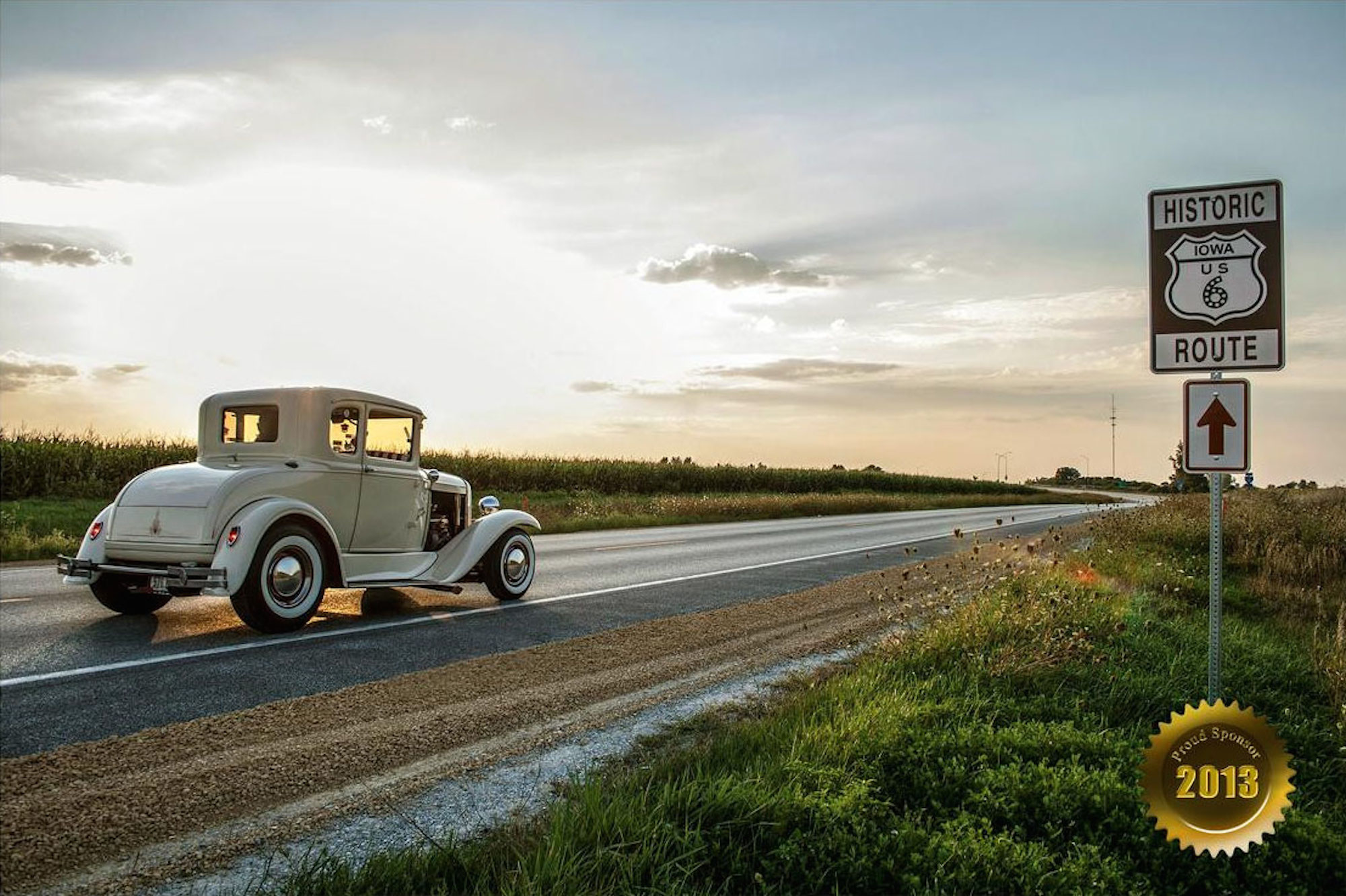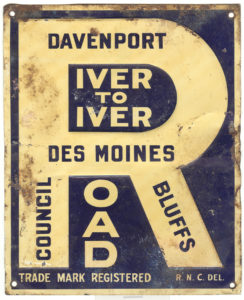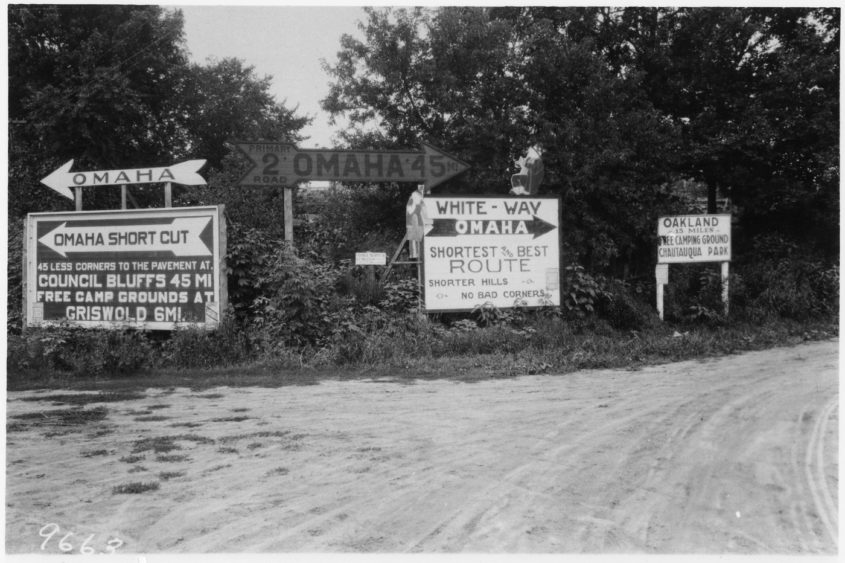River to River Road
Grandfather of Highway 6, the River to River Road was built in one hour, by 10,000 farmers and volunteers on June 25th, 1910. That’s right. One Hour. At 9 am, on a Saturday morning 10,000 farmers and volunteers picked up their implements, and one hour later, at 10 am, a road was created that would change the history of Iowa transportation forever. It was a shot that was heard around the world. The River to River Road ran all the way across Iowa, from Davenport to Council Bluffs, going through Durant, Wilton, Moscow, Atalissa, West Liberty, Iowa City, Coralville, Tiffin, Oxford, Homestead, South Amana, Marengo, Ladora, Victor, Carnforth, Brooklyn, Grinnell, Kellogg, Newton, Colfax, Mitchellville, Altoona, Des Moines, Waukee, Ortonville, Adel, Redfield, Dale City, Monteith, Guthrie Center, North Branch, Exira, Oakfield, Lorah, Atlantic, Marne, Walnut, Avoca, Minden, Neola, Underwood, and Weston in between.
Some of these towns on this route no longer exist. Some were later bypassed over time, but Highway 6 still services many of them. Much of the River to River Road was based on the Iowa City-Newton-Fort Des Moines Stagecoach Route, established in 1844 as a transportation link between the original capitol in Iowa City, and Fort Des Moines. This stagecoach route was the first legally defined by the state legislature and was designed to serve as a supply route to the dragoons stationed at the Fort. The route served that purpose until 1869 when the Rock Island Railroad was extended westward to Des Moines.
When Iowa began its numbering system July 1st, 1920, the River to River Road was numbered as IA Primary Road 7. Ironically, the number 6 went to the Lincoln Highway! In 1921 the River to River Road took a blow as the Detroit-Lincoln-Denver Highway (DLD) association, formed September 6th, 1921 started painting over nearly all of their “R” markers, from Iowa City to Des Moines. Because the markers were protected by the Iowa State Registration law, the D.L.D. was ordered to repaint all the markers. Meanwhile the River to River Road Assn elected to allow the D.L.D. to share the route. The writing was on the wall, however, and the River to River Road Association was declared “defunct” on October, 19, 1925.
The Great White Way
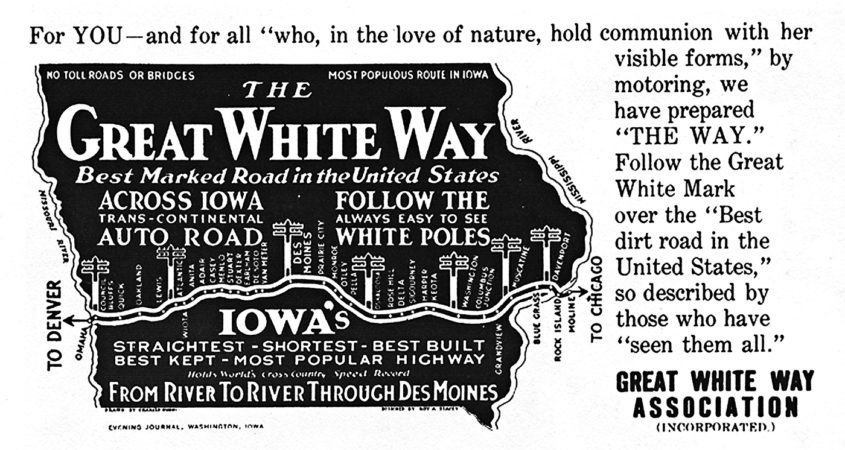 Meanwhile, the Southwestern Auto Club, from a group of 5 towns (listed below in italics) just south of that path figured that they had a better route. Straighter, with fewer hills, they created the White Pole Road. Taking a more southern route out of Council Bluffs, through Quick, Oakland, Lewis, Atlantic, Wiota, Anita, Adair, Casey, Menlo, Stuart, and Dexter, the White Pole Road, which eventually became the Great White Way, extended eastward through Earlham, Desoto, Van Meter, Des Moines, and by the end of 1912, onward through Prairie City, Monroe, Otley, Pella, Oskaloosa, Rose Hill, Delta, Sigourney, Harper, Keota, Washington, Columbus Junction, Muscatine, then Blue Grass, and on into Davenport.
Meanwhile, the Southwestern Auto Club, from a group of 5 towns (listed below in italics) just south of that path figured that they had a better route. Straighter, with fewer hills, they created the White Pole Road. Taking a more southern route out of Council Bluffs, through Quick, Oakland, Lewis, Atlantic, Wiota, Anita, Adair, Casey, Menlo, Stuart, and Dexter, the White Pole Road, which eventually became the Great White Way, extended eastward through Earlham, Desoto, Van Meter, Des Moines, and by the end of 1912, onward through Prairie City, Monroe, Otley, Pella, Oskaloosa, Rose Hill, Delta, Sigourney, Harper, Keota, Washington, Columbus Junction, Muscatine, then Blue Grass, and on into Davenport.
The Great White Way was numbered IA Primary Road 2 July 1st, 1920.
The distance of the Great White way across Iowa was 321 miles, while that of the River to River Road was 346 miles. The disparity was west of Des Moines, perhaps because the River to River Road dipped south, to service Atlantic. East of Des Moines, the River to River Road held a slim 2 mile advantage. Because of this extra distance, 75 percent of people west of Des Moines traveling to Council Bluffs took the Great White Way. All of these factors tied into what happened next…
Courting Controversy – Whiteway-7 Highway
In 1922, the newly formed Whiteway-7 Highway Association approached the Iowa State Highway Commission and told of their proposal to create a new main east/west route from Chicago to Omaha. They wanted to merge the old River-to-River road with the old Great White Way to connect with the No. 7 routes in neighboring states, Illinois and Nebraska.
These three states then became the short-lived “Chicago-Omaha Short Line Highway Association”. Incidentally, the association’s Iowa Vice President was Judge George B. Lynch of Adair who had also been the Chairman of the Membership Committee for the Great White Way Association.
On September 25, 1922, at the request of the Whiteway-7 Highway Association, IA 7 and IA 2 switched routes between Des Moines and Council Bluffs so that the IA 7 route west of Redfield became IA 2 and the IA 2 west of Dexter became IA 7. The problem was that the commission did this with no public hearing because it had been assumed that neither of the old road associations was really active at the time.
This merger created even more controversy between the routes, and now there was confusion with tourists and residents in the eastern part of the state with the old River-to-River road now being called Whiteway-7 which diverted people from the original Great White Way. In the western part of the state, they objected because the old No. 7 Highway still existed there and now there was a southern Whiteway-7.
In an annual meeting on October 18th in Oskaloosa, the Great White Way Association met and elected its president W.H. Fowler of Pella with officers from Monroe and Oskaloosa. They went on to file a “vigorous protest” with the State Highway Commission in regards to the new Whiteway-7 markings. The state responded that it wouldn’t accept the registration for the Whiteway-7 as long as the Great White Way continued to exist. But later on the 31st, the “last legally elected President and Secretary of the Great White Way Association” cancelled the registration mark with the State Highway Commission… that being Harvey Ingham of Des Moines and Roy Stacey of Adair. In fact they claimed that the association ceased to exist on January 1st, 1915 and that any alleged new officers were not elected at the principal place of business, which according to the bylaws is Des Moines.
These arguments along with affidavits were submitted by Judge Lynch of Adair to the highway commission’s chief engineer on November 4th. Despite the rally by the eastern part of the state to maintain the Great White Way, the new Whiteway-7 was proclaimed in December of 1922.
But there were many protests across the state… especially in the western area. So on May 7, 1923, the Highway Commission changed everything back. No. 7 was 7 and No. 2 was again 2… but No. 2 was also referred as the White-way 7 west of Dexter to Council Bluffs. So the western half of the state had two 7’s as numbered roads! Judge Lynch asked for the numbering case to be reopened and a hearing in the State Commission’s office in Ames resulted on May 29, 1923. The state’s chief engineer even admitted in a letter to Lynch that the state had “gotten themselves into a mess”! On July 9, 1923 the State decided that the original numbering should be upheld but they didn’t have jurisdiction over the Whiteway-7-Highway designation, so that signage could continue… and the rivalry continued.
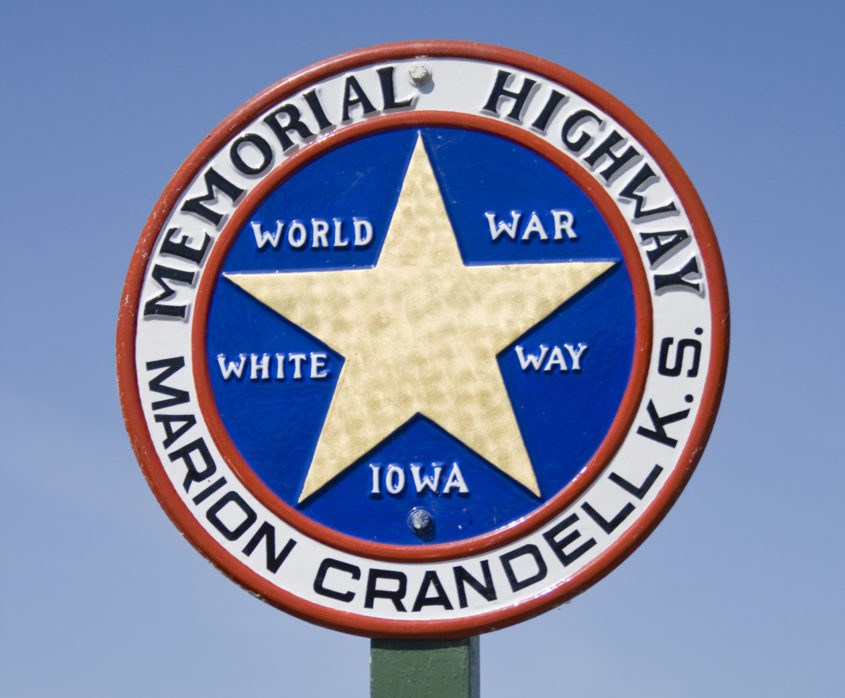
The entire 1922-1923 alignment was named “White-Way Memorial Highway” June 11th, 1925. But the story isn’t over yet. On October 19, 1925, the “River to River Primary Number 7 Highway Association” requested a route, wanting #7 to be re-assigned to the River-to-River Road. The commission ruled that the previous “River-to-River Road Association” was defunct, and as such, the new association would have to re-register to get a route. In addition, the association was not allowed a number, “in conformance with the general policy of the commission which grew out of the disagreeable incident in connection with the White-way 7 Highway affair.”
With the merging of The Great White Way from Council Bluffs to Dexter, along with The River to River Road from Redfield to Davenport as “White-Way 7”, the path of modern day Route 6 (shown in red) was born.
This whole controversy was ruled moot, when the entire route became U.S. Highway 32, on October 16, 1926. Interestingly, the Rand McNally Atlas kept the Whiteway-7 nomenclature, along with the US 32 markings as late as 1929.
And after the massive paving projects from 1926-1930, Iowa would no longer be known as “The Gumbo State.”
U.S. Route 32 became U.S. Route 6 December 31st, 1931.
(From the upcoming book: “River to River: Your Guide to the Original Highway 6” by David W. Darby)
